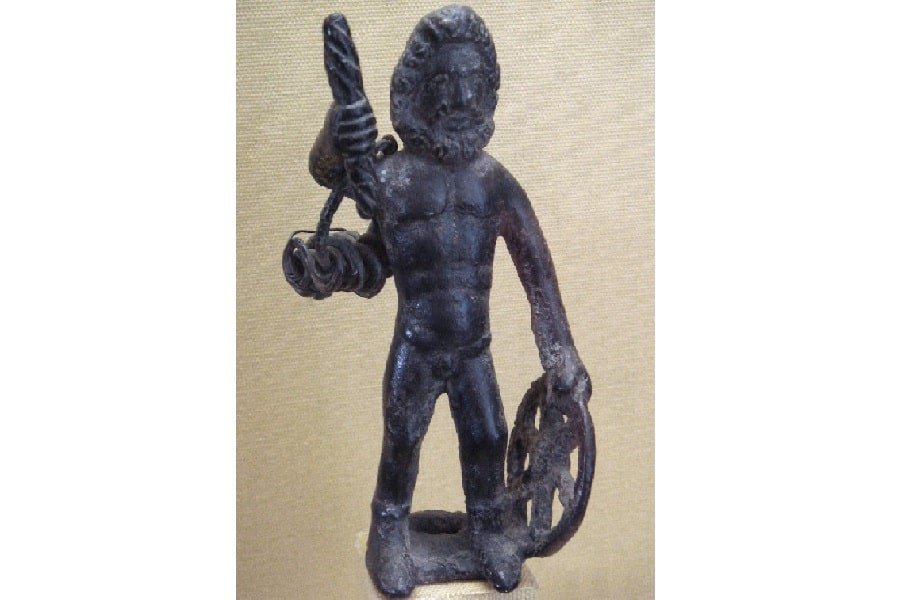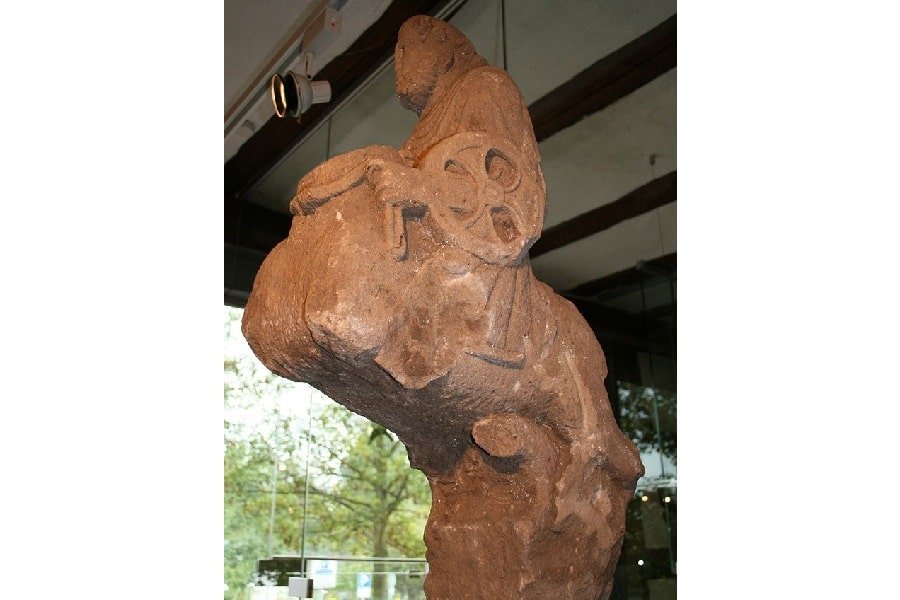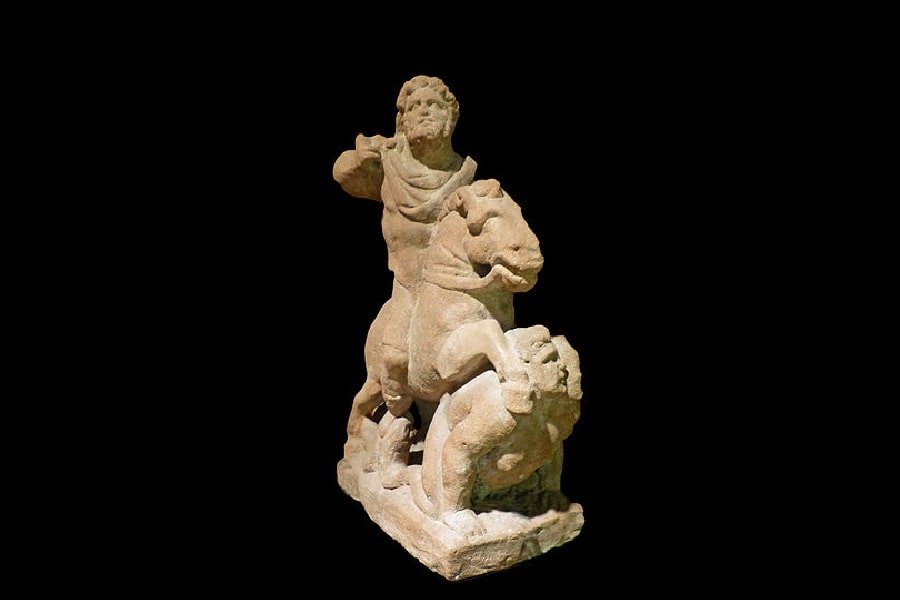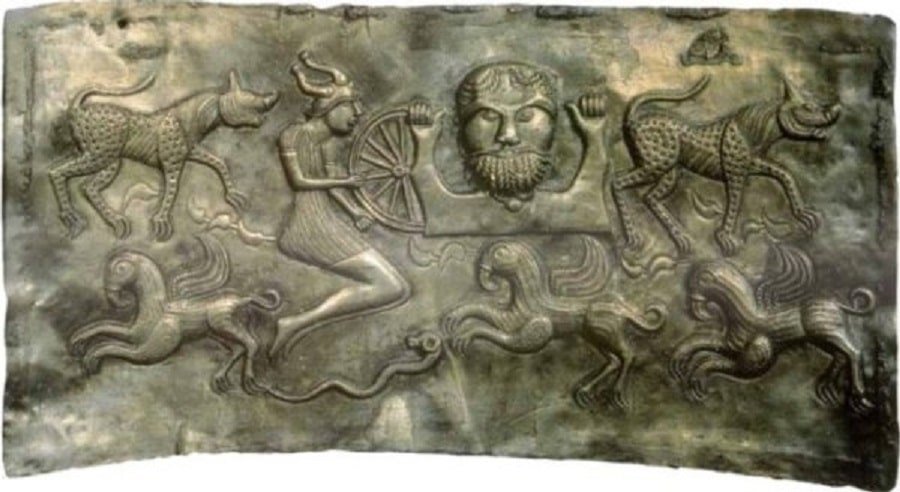Taranis is one of the most intriguing and powerful figures of the Celtic pantheon. He is god of thunder, lightning, and storms and was often depicted with a wheel, representing the celestial nature of thunderstorms and possibly connecting him to the concept of the celestial wheel or the cycle of seasons.
Table of Contents
Who is Taranis

Taranis is an ancient pan-Celtic deity who was widely worshiped in several territories of Western Europe such as Gaul, which encompassed much of France, Belgium, Germany, parts of Switzerland, Northern Italy, and the Netherlands. Other places Taranis was worshiped are Britain, Ireland, Hispania (Spain), and the Rhineland and Danube regions.
Taranis is the Celtic god of lightning and thunder. Additionally, the Celtic god of weather was associated with the sky and heaven. As the Celtic storm deity, Taranis wielded a thunderbolt as a weapon, as others would wield a spear.
In mythology, Taranis was considered to be a powerful and fearsome deity, who was capable of wielding the destructive forces of nature. According to the Roman poet Lucan, the god was so feared, that those who worshiped the Celtic god did so through human sacrifices. Although no archeological evidence has been found to support his claim.
Although the god of thunder is a powerful figure within Celtic mythology, very little is known about him.
Taranis the Wheel God
Taranis is sometimes referred to as the wheel god, because of his association with the wheel, with which he was often depicted. The wheel was one of the most important symbols in Celtic mythology and culture. Celtic wheel symbols are called Rouelles.
Symbolic wheels can be found throughout the ancient Celtic world. These symbols have been found in shrines, graves, and settlement sites from the Middle Bronze Age.
READ MORE: Ancient Civilizations Timeline: 16 Oldest Known Cultures From Around The World
In addition, wheels were found on coins and were worn as pendants, amulets, or brooches which were usually made of bronze. Such pendants were thrown into rivers and are associated with the cult of Taranis.
The wheel symbols used by the ancient Celts are believed to have represented mobility, as wheels were found on wagons. The ability to transport themselves and goods was a strength of the ancient Celts.

Why Was Taranis Associated With the Wheel?
The link between mobility and the god Taranis is thought to be because of how swiftly the god could create a storm, a natural phenomenon that the ancients feared. The wheel of Taranis usually possessed eight or six spikes, making it a Chariot wheel, rather than the four-spiked solar wheel.
Although the exact symbolism behind the wheel of Taranis has been lost, scholars believe it could be linked to the ancient’s understanding of the natural world and phenomena. The Celts, like most of our predecessors, believed that the sun and moon were pulled across the sky by chariots.
The wheel of Taranis therefore could have been related to the belief that a solar chariot was pulled across the heavens daily.
Etymology of Taranis
The name Taranis can be traced to the Proto-Indo-European word for thunder, stem. The name Taranis is also derived from the proto-Celtic word for thunder, Toranos. The original name is believed to have been Tanaro or Tanarus, which translates to thunderous or thundering.
The Origin of Taranis
Worship of the ancient storm deity dates back to the prehistoric era when the Proto-Indo-European people made their way across Europe into India and the Middle East. Where these ancient people settled, they introduced their religion, thus spreading their beliefs and deities far and wide.
What Does Taranis Look Like?
In Celtic mythology, the god of thunder was often depicted as a bearded, muscular warrior holding a wheel and a thunderbolt. Taranis is described as being neither old nor young, rather he is shown as being a vigorous warrior.

Taranis in the Historical Record
What little we know of the ancient Celtic sky god, Taranis, is mostly from Roman poems and descriptions. Other inscriptions that mention the god and provide a tiny piece of the ancient puzzle have been found in Latin and Greek. Such inscriptions have been found in Godramstein in Germany, Chester in Britain, and several sites in France and Yugoslavia.
The earliest written record of the thunder god is found in the epic Roman poem Pharsalia, written in 48 BCE by the poet Lucan. In the poem, Lucan describes the mythology and pantheon of the Celts of Gaul, mentioning the main members of the pantheon.
In the epic poem, Taranis formed a sacred triad with the Celtic gods Esus and Teutatis. Esus is thought to have been associated with vegetation while Teutatis was the protector of tribes.
Lucan was one of the first scholars to draw attention to the fact that many of the Roman gods were the same as the Celtic and Norse gods. The Romans conquered the vast majority of the Celtic territories, fusing their religion with their own.
Taranis in Art
In an ancient cave in France, Le Chatelet, a bronze effigy of the thunder god was found believed to have been crafted sometime between the 1st and 2nd centuries. The bronze statue is believed to be of Taranis.
The statue shows the bearded Celtic god of storms holding a thunderbolt in his right hand, and a spoked wheel in his left, hanging down by his side. The wheel is the identifying aspect of the statue, distinguishing the god as Taranis.
The god is also believed to be depicted on the Gundestrup Cauldron, which is a remarkable piece of artwork thought to have been created between 200 and 300 BCE. The panels of the intricately decorated silver vessel show scenes depicting animals, rituals, warriors, and gods.
One of the panels, an interior panel called panel C, seems to be of the sun god, Taranis. In the panel, the bearded god is holding a broken wheel.

The Role of Taranis in Celtic Mythology
According to myth, the wheel god, Taranis, wielded power over the sky and could control frightening storms. Because of the great power Taranis controlled, he was considered to be a protector and leader within the Celtic pantheon.
Taranis, like his Roman counterpart, was quick to anger, the outcome of which would have destructive consequences on the world. The storm deities’ temper tantrums would result in sudden storms that could wreak havoc on the mortal world.
As previously mentioned, we do not know an awful lot about Taranis and many of the Celtic myths are lost to us. This is because the myths were passed down through oral tradition and were therefore not written down.
Taranis in Other Mythologies
The people of the aforementioned regions were not the only ones who worshiped Taranis. He appears in Irish mythology as Tuireann, which is featured prominently in a story about Lugh, the Celtic god of justice.
To the Romans, Taranis became Jupiter, who carried a thunderbolt as a weapon and was the god of the sky. Interestingly, Taranis was also often related to the Cyclops Brontes in Roman mythology. The link between the two mythological figures was that both of their names mean ‘thunder’.
Today, you will find mentions of the Celtic god of lightning in Marvel comics, where he is the Celtic nemesis of the Norse thunder god, Thor.